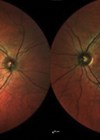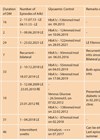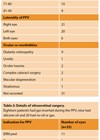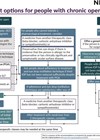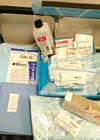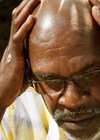Ophthalmology
Possible COVID-19 related maculopathy
COVID-19 is being investigated as a potential cause for various ocular diseases, with growing evidence of related retinal vascular changes, that vary from isolated cotton wool spots and retinal haemorrhages to retinal vascular occlusions [1.2]. COVID-related macular affection has also...
The increased use of surgical adjuncts in complex cataract surgeries undertaken in the COVID-19 pandemic
The authors explore whether more complicated cataract operations have been performed in the NHS since the start of the coronavirus pandemic. Restrictions in availability of access to elective cataract surgery during the COVID-19 pandemic and subsequent case prioritisation based on...
Prevalence of acute anterior uveitis in diabetic patients attending diabetic eye disease clinics
The authors share their investigation at Manchester Royal Eye Hospital into the association between diabetes and AAU. The global prevalence of diabetes mellitus (DM) is rapidly rising from an estimated 9.3% in 2019 to 10.2% by 2030 [1]. The link...
Does vitrectomy increase the risk of glaucoma? A retrospective review from a UK hospital
The authors investigate what proportion of patients undergoing pars plana vitrectomy subsequently developed ocular hypertension or a diagnosis of glaucoma. A systematic review carried out in 2017 including seven studies found that there is evidence that pars plana vitrectomy (PPV)...
Ambitions for sustainable service recovery amidst an escalating post-COVID backlog
Rod McNeil reviews plans, activity and solutions to better address the post-COVID backlog and bolster sustainable service recovery. Ophthalmology was the busiest outpatient specialty during the three years to March 2020 across the English NHS and again recorded the highest...
Ophthalmic Aid to Eastern Europe (OAEE)
Peter Cackett, Tim ffytche and Dr Irina Gout reflect on historic ophthalmic aid sent to Eastern Europe. This article was written prior to the horrific events in Ukraine. An appeal for funds and equipment may be made by OAEE later...
How to pass the FRCOphth Part 1 as a foundation trainee: some practical tips
Attempting the FRCOphth Part 1 examination as a foundation trainee requires significant time and financial commitment. Unlike the MRCP and MRCS examinations, the curriculum of this exam does not overlap with the undergraduate syllabus. As such, it is a steep...
Acute management of retrobulbar haemorrhage
The authors discuss the importance of rapid diagnosis and correct management of acute RBH presentation to avoid the risk of permanent blindness. Retrobulbar haemorrhage (RBH) is an ocular emergency that occurs due to arterial bleeding in the orbital cavity behind...
Dr William Mackenzie: a founding figure of modern ophthalmology
The author looks at the career of William Mackenzie and the important role he played in establishing the status of ophthalmology as a recognised medical speciality. There are certain individuals who, blessed with ability and means, are destined to leave...
Dementia and visual impairment: what is the relationship and are we providing the best care?
Carla Maden discusses the implications of living with both dementia and visual impairment, and how general medical junior doctors and ophthalmologists can help to alleviate this burden and improve the quality of life of such patients. Dementia and visual impairment...
Working smarter not harder: How to transform eyecare delivery in the United Kingdom (part 2)
Are we doing enough to meet the current demands on ophthalmic services? In part two of a two-part series (see Part 1 here), Rosalind Harrison explains how efficiency can be improved by setting up eye services in community hubs. The...
Unexpected diagnoses – stroke in children and homonymous hemianopia
We present the case of a 12-year-old child presenting with a few days history of left-sided visual loss. Upon further investigation with magnetic resonance imaging (MRI) she was unexpectedly diagnosed with a right-sided chronic posterior cerebral arterial territory infarct, causing...


